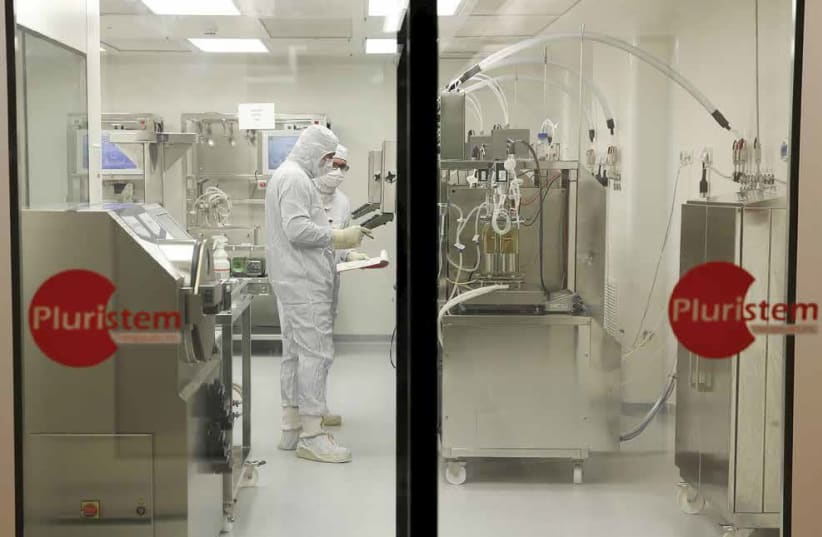By the end of June 2018, Haifa-based Pluristem Therapeutics Inc., a clinical-stage biotherapy company using placental cells and a unique, proprietary, three-dimensional technology platform to develop cell therapies, will have the results of its meaningful Phase II IC clinical trial. According to Pluristem Co-CEO Yaky Yanay, medical professionals and IC sufferers around the world are waiting on the edge of their seats for these results because as of today, there is no effective treatment.
“The standard practice is to treat these patients with painkillers, such as opiates or anti-inflammatory drugs, which just masks the pain and leaves the patient chronic,” explained Yanay.
Peripheral Arterial Disease (PAD) is caused by fatty deposits in leg arteries that obstruct blood flow. Risk factors include smoking, diabetes, heavy weight, cardiovascular problems and hypertension.
IC has a high likelihood of progressing to critical limb ischemia (CLI), a severe obstruction of the arteries that markedly reduces blood flow to the extremities and causes severe pain and even skin ulcers or sores. The pain caused by CLI can wake up an individual at night. Many CLI patients ultimately have their affected limbs amputated, which puts them at high risk for co-morbidities and even death.
Yanay said an estimated 20 million people in the United States and 60 million people in China suffer from PAD, putting a financial strain on the healthcare systems.
“Today, there is no good solution to treat these patients,” said Yanay. “CLI is a silent killer.”
Pluristem’s Phase II trial included 172 patients, of which some 40% received placebo treatment. The other 60% received courses of Pluristem’s PLX-PAD intramuscularly three months apart. The study was multinational, randomized and double blind. The 172 patients came from the US, Germany, Israel and South Korea.
The primary efficacy endpoint was the change in maximal walking distance one year after the first administration. Other endpoints included the change in initial claudication distance, hemodynamic parameters (ankle-brachial index, toe-brachial index), quality of life score, and the rate of revascularization.
Major US clinics participated in the study, including the Medical College of Wisconsin. Turkey Creek Medical Center in Tennessee, Hospital of the University of Pennsylvania, Duke University Hospital and Tampa Bay Medical Research, among others.
Pluristem Co-CEO Zami Aberman explained that the PLX-PAD cells used for the trial are extracted from the placenta in Pluristem’s proprietary platform located in the company’s manufacturing facility in Haifa. The PLX cells are then frozen and stored, readily available for use, requiring no tissue or genetic match between the cells and the patient. The secreted proteins, administered through intramuscular injections, initiate a self-healing process in the patient’s body.
“We need an agent that can communicate with the body on a systemic level, which is what Pluristem’s placenta cells can do,” said Yanay. “Our cocktail of proteins pushes the body toward regeneration.”
Before PLX-PAD, doctors tried multiple other solutions. For example, previous research indicated that autologous stem cell therapy – when the cells are taken from the patient’s body and reinjected into his or her leg – looked promising in pre-clinical trials. But when later stage trials of autologous stem cell therapy took place, the solution failed.
According to Lars Norgren, emeritus professor at Örebro University in Sweden, one reason Pluristem’s PLX-PAD cell therapy is so desirable is that the placenta cells being used in the therapy are better quality than those that were used with autologous stem cell therapy. He said that the cells are derived from the placentas of young, healthy women following full-term delivery, could make the difference. Further, said Norgren, Pluristem’s cells can be administered off-the-shelf without tissue matching.
While no results of this most recent Phase II IC study are yet available – even to Pluristem – Yanay said previous studies do indicate that the PLX-PAD cells can be effective.
He said smaller CLI Phase I and II studies were able to demonstrate a close to 60% reduction in risk of amputation and death.
In addition, Pluristem was also recently accepted into the United States’ FDA expanded access program, which allows Pluristem to treat patients with this serious, life-threatening condition who do not meet the enrollment criteria for the Phase III clinical trial in progress.
“Pluristem has the potential to generate hope for all patients that currently have no other medical solution,” said Aberman.
Added Yanay, “We are hopeful to be able to demonstrate what everyone is waiting to see.” This article was prepared in cooperation with Pluristem Therapeutics Inc.

